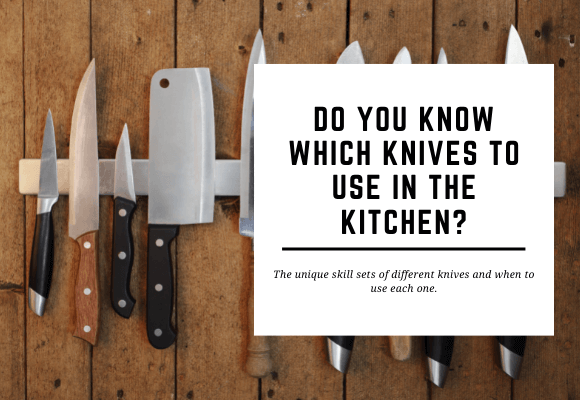
Do You Know Which Knives to Use in the Kitchen?
Knowing which cutlery to use may be a sign of ‘good breeding’, but knowing which knife to use in the kitchen is a sign that the food you cook is going to be good. No matter which fork you use or how you hold it, your skills in the kitchen are the ones that give your food that wow factor. Knowing which knife to use for which food and purpose makes food preparation easier, and gives your food that professional finish. Here’s a list of the most commonly used knives you’re likely to come across.
Chef’s knife
Every knife collection needs a Chef’s Knife. A Chef’s Knife is used for chopping, slicing, precision cutting, crushing, and carving, so it’s an extremely useful knife. Most Chef’s Knives are around 25 cm long and have a long, curved edge and a broad blade. Smaller versions can be handy to have in your collection but master the 25 cm version before you move on to the smaller ones.
Cleaver
Swinging a traditional European Cleaver around might make you feel like a real chef, but most chefs have little use for them. European Cleavers have a thick, heavy blade with the edge set at an angle. They’re designed to work as an axe to cut through bone, but they can often leave splinters, so a meat saw is usually a better option.
Chinese Cleaver
A Chinese Cleaver, however, can be very useful. Similar to the short, deep knives of Portuguese and Spanish chefs, Chinese Cleavers have a curved blade for fine chopping and a large blade area for lifting and carrying food as you work. A Chinese Cleaver is suitable for most chopping tasks, as well as slicing and precision cuts.
Boning Knife
As their name suggests, Boning Knives are used for separating meat and connective tissue from bones. Their thin, pointed blades are around 12 cm long and can be stiff or flexible. Some have a straight blade while others angle upwards. The tip of the blade does most of the work, so that must be extremely sharp. Always point the tip away from you when working with a Boning Knife, and never use one on frozen, or partially frozen, food.
Paring Knife
The short, straight blade of a Paring Knife makes it suitable for peeling, trimming, cutting, and intricate work, such a fruit and vegetable carving. Paring Knives are often the ones that get taken, and sometimes lost, on picnics; so get a few cheap ones that you can take around to picnics, and a good one for your main collection at home.
Turning Knife
The Turning Knife is small like the Paring Knife but has a curved blade for shaping vegetables. Like the Paring Knife, its size makes it attractive to outdoor adventurers. Get a good one for home and a few inexpensive ones for picnics.
Carving Knife
Carving Knives have long, thin, narrow blades with sharp, pointed tips. They’re designed to slice and separate cooked meat from the bone, often at the dining table. Straight edged Carving Knives are easier to sharpen and give a smoother cut, but some people prefer a serrated blade. Carving Knives are used with Carving Forks, so you may wish to buy a decorative pair for that fine dining elegance.
Serrated Knife
Serrated Knives look like Ham Slicers, but are better used for softer foods like cake. They are difficult to sharpen, but when used for their intended purpose (cutting bread and other foods with a hard crust), they’ll keep their sharp edge for years. Along with the Chef’s Knife, the Serrated Knife is an essential part of your knife collection.
Serrated Utility Knife
Much like a serrated Chef’s Knife, this knife is used for cutting through lobster and other crustaceans. It can also be handy for cutting non-food items around the home. Like the Paring Knife trick, keep a good one for your collection and get some inexpensive ones with coloured handles that can be used for household tasks.
Steak Knife
Steak Knives are used by butchers to slice steaks from whole cuts of meat. Steak Knives come in different styles and lengths, but the most useful one for your collection will have a comfortable, slip-resistant handle and a thin 25-30 cm blade, which curves up to a fine tip.
Filleting Knife
An essential item for the seafood chef, this knife is similar to the Boning Knife, but with a longer handle. The less common Flexible Filleting Knife has a blade so flexible that it can be bent back onto itself, but this is only necessary if you fillet fine-boned fish with soft bones.

